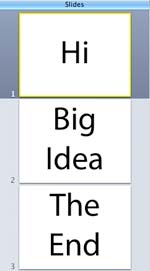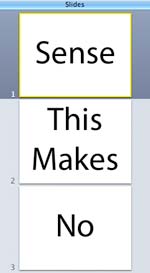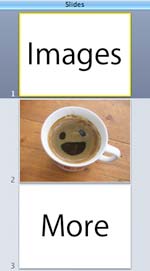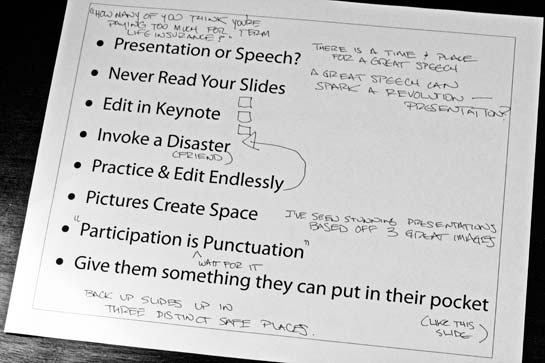It’s the calm before the presentation storm. Over the next three months, I’ve got four different presentations at Webstock and SXSW. I’m also the best man at a wedding in Washington, all of which means I’m spending most of my down-time thinking up things I’m going to say in the future.
If you’re looking for advice on giving a presentation, the Internet is chock full of endless advice. I’ve been here, too. If you’re looking for tips on writing the presentation, the Internet goes dark — for a fairly simply reason. To think about how to write a presentation, you need to think about how you speak, and that’s not what you’re doing when you read or write. I’ll demonstrate. Say the following out loud right now:
I am reading this out loud to no one in particular.
Were you surprised to hear your voice? I was. Did you actually read it out loud? No? Why not? Sitting in a coffee shop? Worried that the guy next to you will think you’re a freak? This basic discomfort is the reason it’s tricky to explain how to present in an article. The skills involved in writing a clever paragraph are completely different from those used for developing and delivering that clever paragraph to a room full of strangers.
You still haven’t read it out loud, have you?
Presentation or Speech?
 Developing a compelling presentation involves a series of decisions and exercises to align your head with the fact that you’re delivering your content directly to people. No internet. No weblog. Just you.
Developing a compelling presentation involves a series of decisions and exercises to align your head with the fact that you’re delivering your content directly to people. No internet. No weblog. Just you.
Your first decision: speech or presentation? Wondering about the difference? Take a quick look at these two entirely different appearances by Steve Jobs. The first is his Three Stories speech at Stanford and the second is part of his MacWorld 2007 keynote.
You only need to watch a few minutes of both to get a feel for the difference between a presentation and a speech. My guess is you only viewed the Stanford video because everyone has seen Steve Jobs at MacWorld and the Stanford video is a shocker. Clearly, it’s Steve Jobs. It’s his voice, he’s got his trademark bottle of water, but the delivery is completely anti-Jobs because he’s reading his compelling stories from a piece of a paper.
It freaks me out.
In his autobiography, regarding his stand-up comedy years, Steve Martin writes, “If you don’t dim the lights… the audience won’t laugh.” This subtle, paradoxical observation is the core difference between speeches and presentations. In a presentation, half of the art is figuring out how to create an environment where your audience can actively participate without knowing they are participating. In a speech, the audience may laugh or cry, but they are not required nor encouraged to participate, because, during a speech, the spotlight never leaves the speechmaker.
For a presentation or a speech, you need your audience, otherwise it’s just you in an empty room talking to no one in particular, and we already have a word for that… it’s called writing.
The Unforgivable Mistake
There is one unforgivable mistake when giving a presentation. You’ve heard it before: “Don’t read from your slides.” As you’ll see, my approach for presentation development is designed around avoiding this cardinal mistake, and it starts with picking the right tool.
For all of my presentations during the past three years, I’ve done all my content creation inside of my presentation software, which, thankfully, is Keynote. In the back of my mind, I’ve wondered if this is the right tool to iterate a presentation. Shouldn’t I follow the same process as writing and drop all my thoughts into TextEdit where I can easily slice and dice complex thoughts? No.
Start with and stick with Keynote or whatever presentation software floats your boat. First, presentation software is effectively designed to be outline software and that’s a great tool for organizing and editing your thoughts while not allowing them to become a book. By keeping your presentation in slide format, you’re forcing your content to remain a presentation, not an article. Where each slide is a thought. Where moments of undiscovered brilliance are sitting between bullet points. We’ll talk about how to find this brilliance in a bit, but for now, iterate in the slides.
Your job is to get as much of the meat as possible into outline form so that you can begin to transform it into a presentation. Don’t worry about how you’re going to say something or whether folks are going to get it. If you’re worried that the outline doesn’t allow you to capture the essential detail that you could with a blank piece of paper, start taking notes. I like the stickies in Keynote for random small thoughts. I like the speaker notes for bigger ones.
What’s going to happen as you edit and re-edit is that an initial structure will emerge from your outline. Better yet, since you’ve stuck with presentation software, I’m guessing you’re already starting to hear your voice in your head on certain slides…
- “This is a key point. I need to say this one reeeeeeeeallly slowly because it needs to stick.”
- “Good data that needs to be conveyed, but… dull. Needs hip.”
Once you’ve got what looks like a rough outline of your presentation, it’s time to invoke The Disaster.
The Disaster
This is the second time I’m going to ask you to do something and the second time I just want you to do it. No questions asked. I want you to go to the first slide of your presentation, stand up, and give your presentation.
Wait what whoa Rands this is rough and it’s missing thoughts and uh…
Quiet. Give it a shot. Beginning to end, each slide, I want to hear your presentation.
Done? How’d it go? There’s a reason I call it The Disaster, you know. There are three reasons you should tough out your rough presentation with zero prep:
- Get a feel for how it fits all together.
- Hear yourself speaking. This is more reinforcement that you aren’t writing a book, you’re writing a presentation.
- Build confidence. You now know the absolute worst case scenario regarding this presentation. There is no way it could be worse than what you just went through.
 Did you notice as you stood in your office talking to no one in particular how thoughts in your head sounded different than on the slides? Did you discover flaws in logic? Mysterious new gaps in content on the slides you’ve been staring at all morning? That’s progress.
Did you notice as you stood in your office talking to no one in particular how thoughts in your head sounded different than on the slides? Did you discover flaws in logic? Mysterious new gaps in content on the slides you’ve been staring at all morning? That’s progress.
During the Disaster run-through, I take a ton of notes. I do this on a piece of paper next to the computer because, as much as possible, I want to stick with the idea that I’m giving my presentation. If I stop to edit my slides, I lose track of tempo and momentum, or worse, I end up re-writing my presentation rather than giving it. These handwritten notes look like this:
- No clue what slide #2 is trying to say.
- Segue between #4 and #5 is non-existent
- #10: Repeating myself
Your first job after your Disaster is to integrate your notes as quickly as possible. For me, the post-Disaster edit is also the single biggest change I’ll make to the presentation. In addition to major structural changes, I also find new content that needs to be added.
Reduction
This is a good time to remind yourself how to not throw up. This is the topic of an article from last year I wrote on the topic of preparing to give — not develop — your presentation, and there are huge useful intersections between these articles. For those NADD afflictees out there, I present this article in three slightly revised bullet points:
- Practice endlessly (so that you can)
- Improvise (but never stop)
- Fret (ting)
In terms of developing your presentation, I’m going to further modify bullet #1 for this article. It’s now, “Practice and edit endlessly”. This is the largest piece of work where I have the least advice because you need to stare at your slides at 2am for three nights in a row. You need to soak in your presentation. So, mix it up. Invoke another disaster. Pitch a friend. Print your slides and pitch a tree in the woods.
My best piece of advice is a threat: an audience can smell an immature presentation on the very first slide. It has nothing to do with the quality of the content; it’s you standing lamely in front of your slide and silently conveying the “Ok, what I am going to talk about here?” vibe, and it’s presentation death.
During this endless editing and practice, you’re looking for a reduction and consolidation of slides to occur. It’s not that you’re saying less, it’s that you’re beginning to internalize the content so you no longer need all those words to remember your point. It can be disconcerting to delete your fine ideas, so use the speaker notes or stickies if you feel you’re going to forget something important. You aren’t going to need them, but if it makes it emotionally easier to prune, terrific.
This consolidation is one of the reasons I don’t usually send my slides to folks who ask after the presentation. My slides, standing on their own, rarely make sense without me standing in front of the room furiously waving my arms.
 Second, as part of your consolidation, you’ll want to start thinking about where you want to use images rather than words. Remember, a presentation is a visual and auditory medium, and a slide covered with words is, well, a cop-out. If you’re only going to use words to describe your fine idea, why don’t you just send everyone an email instead of wasting an hour of their time reading the same thought plastered on the wall behind you.
Second, as part of your consolidation, you’ll want to start thinking about where you want to use images rather than words. Remember, a presentation is a visual and auditory medium, and a slide covered with words is, well, a cop-out. If you’re only going to use words to describe your fine idea, why don’t you just send everyone an email instead of wasting an hour of their time reading the same thought plastered on the wall behind you.
This presentation is only partially about you and what you think. Yes, you are the guiding force, but the goal is to present an idea with space around it. In this space, your audience is going to pour their own experience and their opinions; they’re going to make your idea their own. Pictures, charts, and graphs create structured, memorable space. I use them in two ways: either to replace an entire thought wholesale or to augment a word slide that needs more space.
A Design Aside: The visual design of your slides is an important topic that is outside the scope of this article, but know this: I’ve seen people lose their minds tweaking animations and transitions on slides. They try every single animation in the hope that just the right transition will add that certain something to their presentation, but what they don’t know is that an animation fixation is usually a sign that your content blows. The same rule for typefaces applies for transitions and animations. The less your audience sees your design decisions, the more impact they’ll have.
Third, you’re looking for an underlying structure to your presentation that you’re going to want to share with your audience. During all of this endless practice, you’re going to develop a feel for how your presentation fits together, but this structure may not be initially obvious to your audience. For any reasonable-sized presentation, you need to design a visual system that allows audience members to instantly know where they are.
Fourth, and lastly, you’re looking for audience participation opportunities in the flow and tempo of your presentation. Where are you going to turn the lights up a little bit and remind the audience that they’re sitting there, soaking in your thoughts? Let’s talk a bit more about this.
Presentation Punctuation
Participation is presentation punctuation. You’re going to use participation to accentuate parts of your presentation. You’re going to use it to break up complex thoughts into digestible, comfortable ideas. But you only have partial control of when folks will actually participate.
The most common participation technique is the show of hands opener. It’s usually done at the beginning of the presentation as a warm-up:
- “Show of hands — how many of you own a Mac?”
- “Quickly, how many of you think you’re paying too much for term life insurance?”
As a warm-up technique, I’m a fan of the opener. It’s an up-front reminder that this is not a speech, it’s just an opening salvo and you’ve got another hour to fill. As you’re endlessly practicing your slides, look for sections that are idea-heavy and give your audience a shot in the arm with a question. You don’t even have to ask for a show of hands, just direct the spotlight at them for a moment.
Tell me exactly what you do with your fingers when you read at your computer.
You’re only going to be able to plan so much of your audience’s participation, and therein lies the beauty of actually giving a presentation: you don’t know when your audience is going to show up. Dull, wordy slides I considered deleting often got the biggest laugh. Visual slides that I’ve poured my heart into are often complete duds. You won’t know until you’re there.
Something for their Pocket
What do you want your audience to remember? I should’ve asked this at the beginning, but I’m asking it now because you’re almost done with your presentation and I want to know what your giving your audience that fits in their pocket. I want to know what part of your presentation is actually going to leave with them.
There’s a really easy and cheap way to do this and it’s the Lessons Learned slide. It’s the bulleted list of important points slide that, when displayed, invariably results in a slew of cameras and iPhones appearing in the audience because they know this slide fits in their pockets.
Regardless of whether or not you use it, the Lessons Learned slide is a handy one to have at the end of your deck during the entire presentation development. It defines the basic structure of your presentation and represents a goal. Could you give your entire presentation from a single slide. 50 minutes, a room full of people, and you with your single slide with six bullet points?
That’s your goal, and you can have a wildly successful presentation without achieving it, but a one-slide presentation represents the ultimate commitment to your audience. It says, “This isn’t about slides. This about me telling you a great story… out loud.”

30 Responses